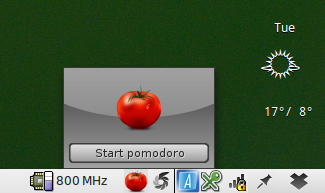
Reviewing and recording efforts are a crucial aspect of success with the Pomodoro technique. While this is enough to start off with the Pomodoro technique, advanced users prefer to record a list of all possible tasks onto a longer 'activity sheet.' Each morning, a bunch of these tasks are pulled from this activity sheet and placed on the to-do list for the day, along with any other more pressing tasks. Smaller tasks that take less than one pomodoro are combined and condensed into one task. Larger tasks that take longer than 5-7 pomodoros must be broken down into sub-tasks. As part of the technique, the user must work on the task at hand interval after interval (each interval is called a pomodoro) until the task is completed it is then checked off the list. The user then picks one task from the list and starts the timer. The technique protocol begins with the user writing down a list of the day’s tasks onto a ‘to-do list’ at the start of the day. The Pomodoro technique is decidedly low-tech in nature to put it to use, you’ll need nothing but a sheet of paper, a countdown timer, and a pen or pencil. In the Field: Using the Pomodoro Technique Cirillo recommends using a similar kitchen timer, since the physical action of winding the timer and its subsequent ticking sounds not only create a sense of urgency, but, over time, become associated with urgent, furtive, focused and productive action itself. Since each interval is a mere 25 minutes long with a 5 minute break in-between intervals, the technique also improves concentration levels and helps to manage stress.Ĭirillo originally used a kitchen timer shaped like a tomato ( pomodoro is Italian for tomato) to time the intervals, hence the name for the technique. The act of initiating a count-down timer and working within a small time frame enforces single-tasking and reduces procrastinating tendencies. After four such 30-minute sessions, you take a longer break, usually 15 to 30 minutes. After 25 minutes of continuous working, you are allowed a five minute break. Subsequently, each task is worked on in 25 minute intervals until completion. The Pomodoro technique works on a simple premise: all the possible tasks for a day are written down in a to-do list.


It has since spread to many other professions.
#Tomighty adjust sound software
Since then, it has spread its wings throughout the world, driven largely by favorable word-of-mouth reviews and wide-scale adoption among software programmers (who use a similar concept in software design, called timeboxing). The Pomodoro technique was invented in the late 1980s by Francesco Cirillo, an entrepreneur, mentor and instructor. Work for twenty-five minutes, take a break for five, repeat: this is the premise of the Pomodoro technique, a simple time management technique that skips minutely planned and prioritized task lists in favor of a simple, frugal approach to productivity. Pomodoro Productivity: A Simple Time-Management Technique to Eliminate ProcrastinationĪre you looking for a more relaxed, simplistic approach to time management? The Pomodoro technique may be just what you're looking for, especially if you're a creative type.


 0 kommentar(er)
0 kommentar(er)
